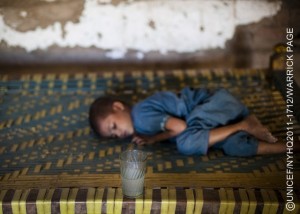聯合國兒童基金會/世界衞生組織:應對肺炎和腹瀉的新計劃每年可挽救200萬名兒童的生命
2013-04-12
日內瓦/華盛頓/香港,2013年4月12日──聯合國兒童基金會(UNICEF)與世界衞生組織(WHO)今日推出一項嶄新的全球行動計劃,預料每年將可避免200萬名兒童死於全球5歲以下兒童的頭號殺手──肺炎和腹瀉。
![Community Health Volunteer Mariam Diarra times eight-month-old Gimbala Keitas eathing, using a WHO/UNICEF timer, during an outreach visit in Kabe Village in the western Kayes Region. The baby has pneumonia. Ms. Diarra has been trained to count a childs eaths to gauge respiratory distress and identify pneumonia. If detected early enough, the illness can be treated with antibiotics and recovery may be swift. Otherwise, the child will be referred to the nearest health facility. Community health volunteers provide basic health services and monthly outreach, helping to manage early childhood diseases in their communities. UNICEF supports community-led initiatives to raise awareness about essential family practices, which include exclusive eastfeeding for babies during the first six months of life, fully vaccinating children under age one, sleeping under insecticide-treated mosquito nets, and washing hands with soap. Each volunteer visits about 35 households (or 250 inhabitants) every month. Ms. Diarra is the eldest of three wives who, all together, have 14 children. [#2 IN SEQUENCE OF THREE] In May 2010 in Mali, the country remains one of the poorest in the world, with more than 47 per cent of the population living on less than US $1.00 a day. Many people lack access to basic health care and safe water, and more than half are without adequate sanitation. Maternal and child health indicators are also among the worlds worst: Eight women die from pregnancy-related causes each day, and nearly 20 per cent of children die before reaching their fifth birthday. Pneumonia, diarrhoea, malaria and neonatal conditions are the primary causes of under-five deaths. Additionally, more than one-third of child deaths are directly related to under-nutrition, and about 38 per cent of Malian children are stunted. Wide economic, gender, geographic and other disparities also persist. Working with the Government and other partners, UNICEF supports health, nutrition, water and sanitation and hygiene (WASH), education and protection interventions, especially in rural areas and among vulnerable populations.](/wp-content/uploads/2015/12/20130415_gappd_1-300x214.jpg)
![A health worker prepares a pentavalent vaccine at a health centre in the community of Corosal in Cobán Municipality, in Alta Verapaz Department. The pentavalent vaccine protects against five common diseases: diphtheria, tetanus, pertussis (whooping cough), hepatitis B and Haemophilus influenza type b (also called Hib, a cause of pneumonia and meningitis). The centre, which is open once a month, serves a population of 1,000, and is run by the Ministry of Health with support from UNICEF. Volunteer health workers provide routine health care and immunizations for pregnant women and children under 5 in five surrounding communities. [#2 IN SEQUENCE OF THREE] In November 2012 in Guatemala, the Government and other partners are continuing to assure sustained routine immunization of children now reaching 92 per cent of all infants against a range of vaccine-preventable diseases. The countrys last endemic case of measles was in 1997. In the entire Americas Region (covering North, Central and South America), the last endemic measles case was in 2002 and the last endemic case of rubella was in 2009 part of global efforts to eradicate these diseases. Worldwide, measles remains a leading cause of death among young children: In 2010, an estimated 139,300 people mainly children under the age of 5 died from the disease. Nevertheless, these deaths decreased by 71 per cent from 2001 to 2011, thanks in part to the Measles & Rubella Initiative, a global partnership led by the American Red Cross, the United Nations Foundation, the United States Centers for Disease Control and Prevention (CDC), WHO and UNICEF. In Guatemala, despite this success, significant other challenges for children remain, much of it related to poverty levels that affect more than half of all children and adolescents. Poverty also contributes to chronic malnutrition affecting half of all under-5 children (with higher rates among indigenous populations); an average national education level of under six years of primary school (under three years for the rural poor); and high, though decreasing, rates of violence. Guatemala is also one of the worlds most vulnerable countries to climate change, suffering a major climate-related emergency every year since 2008. On the positive side, birth registration is improving, with more than 95 per cent of newborns now being registered. UNICEF is working with the Government and other partners to sustain achievements in health, address the high levels of malnutrition, strengthen responses to crimes against children and increase protection services for children throughout public services.](/wp-content/uploads/2015/12/20130415_gappd_4-300x214.jpg)
「預防及控制肺炎和腹瀉的綜合性全球行動計劃」(Integrated Global Action Plan for the Prevention and Control of Pneumonia and Diarrhoea)呼籲各界人士群策群力,共同防治這兩種疾病,又同時確立降低死亡率、改善兒童享用拯救生命干預措施服務的宏遠目標。
WHO孕產婦、新生兒、兒童和青少年衞生司司長伊莉莎白.馬松(Elizabeth Mason)博士表示:「應對肺炎和腹瀉的策略方案往往各自為營。然而,孟加拉、柬埔寨、埃塞俄比亞、馬拉維、巴基斯坦和坦桑尼亞等國家的經驗已經證明,更緊密地整合這些策略方案,在改善健康和提升經濟效益方面都很有意義。」
 由於可導致肺炎和腹瀉的原因很多,單一的干預措施並不能有效地防治或控制肺炎或腹瀉。較富裕的國家已經證明,有些因素對減少這兩種疾病造成的感染及死亡個案至關重要。例如,良好的營養和乾淨的環境,有助保護兒童避免感染肺炎和腹瀉;正獲採用的新型疫苗,亦可以保護兒童免受疾病感染;良好的醫療服務和正確用藥,可以確保兒童得到所需治療。但是,低收入與中等收入國家,在目前多項應對肺炎和腹瀉的工作上,仍未充分顧及到這些因素。
由於可導致肺炎和腹瀉的原因很多,單一的干預措施並不能有效地防治或控制肺炎或腹瀉。較富裕的國家已經證明,有些因素對減少這兩種疾病造成的感染及死亡個案至關重要。例如,良好的營養和乾淨的環境,有助保護兒童避免感染肺炎和腹瀉;正獲採用的新型疫苗,亦可以保護兒童免受疾病感染;良好的醫療服務和正確用藥,可以確保兒童得到所需治療。但是,低收入與中等收入國家,在目前多項應對肺炎和腹瀉的工作上,仍未充分顧及到這些因素。
UNICEF健康計劃全球負責人米奇.喬普拉(Mickey Chopra)博士表示:「這是一個關乎均衡的問題:雖然低收入國家的貧困兒童,他們面臨因肺炎或腹瀉死亡的風險最大,但是卻更難獲得所需的干預措施服務。」他補充道:「我們非常清楚我們的目標。如果我們在死亡率最高的75個國家,為所有人提供僅20%最富有家庭享有的基本干預措施服務,我們最快就可以在2015年實現《千禧發展目標》的最後期限內,挽救200萬名兒童的生命。」
 WHO/UNICEF的新行動計劃,明確地確立了到2025年前要實現的全球目標:將因嚴重肺炎和腹瀉造成的5歲以下兒童死亡率,在2010年的水平上減少75%,基本上根除這兩種疾病造成的5歲以下的兒童死亡個案。此外,將全球5歲以下兒童患上發育遲緩的數目減少40%。
WHO/UNICEF的新行動計劃,明確地確立了到2025年前要實現的全球目標:將因嚴重肺炎和腹瀉造成的5歲以下兒童死亡率,在2010年的水平上減少75%,基本上根除這兩種疾病造成的5歲以下的兒童死亡個案。此外,將全球5歲以下兒童患上發育遲緩的數目減少40%。
這項行動計劃的目標水平較當前水平顯著為高。例如,這項計劃呼籲讓90%的兒童獲取肺炎抗生素,以及治療腹瀉的口服補液鹽,即在當前水平上分別增加31%和35%;計劃的中期目標,是致力讓至少半數6個月以下嬰兒接受純母乳餵養──在2012年這一數值只有39%;讓所有兒童獲得改善的衞生設施和安全的飲用水──目前相關的獲取比率分別為63%和89%;基於一些國家在採用新型肺炎球菌以及輪狀病毒疫苗方面,已經取得良好進展,計劃目標到預定日期前,實現90%的疫苗接種覆蓋率。 這項行動計劃呼籲各國政府及其他持分者,優先考慮援助最難以獲得防治肺炎和腹瀉服務的人群。在目前因肺炎和腹瀉導致的兒童死亡個案中,近90%發生在撒哈拉以南的非洲地區和南亞地區。
正當國際社會加緊實現《千禧發展目標》中有關衞生的目標(其中包括降低兒童死亡率的目標)之際,這項行動計劃適時推出。國際社會的行動包括聯合國秘書長發起的「每個婦女每個兒童」倡議(Every Woman Every Child initiative)及其旗下的「重申承諾.致力兒童生存」全球運動(Committing to Child Survival: A Promise Renewed)。該運動由UNICEF發起,目前已有170多個國家承諾,到2035年根除所有可避免的兒童死亡。
要擴大和改善保護兒童免患腹瀉和肺炎的工作,以及為患病兒童提供適切治療,更緊密地整合現有各項計劃,以及各類執行者(其中包括社區和私營部門)之間的協作將十分關鍵。此外,亦必需確保所有工作能夠長期執行。











